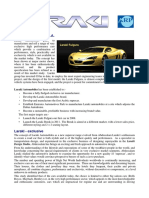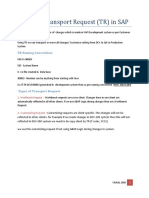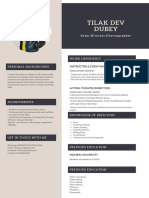100%(1)100% found this document useful (1 vote)
708 viewsManaging To Learn - Detailed A3 Template
Managing To Learn - Detailed A3 Template
Uploaded by
engsilvioluisManaging to Learn -- Detailed A3 Template Title: What change or improvement are you talking about? show visually how much, by when, and with what impact. Use the simplest problem-analysis tool that will suffice to show cause-and-effect.
Copyright:
Attribution Non-Commercial (BY-NC)
Available Formats
Download as PDF, TXT or read online from Scribd
Managing To Learn - Detailed A3 Template
Managing To Learn - Detailed A3 Template
Uploaded by
engsilvioluis100%(1)100% found this document useful (1 vote)
708 views1 pageManaging to Learn -- Detailed A3 Template Title: What change or improvement are you talking about? show visually how much, by when, and with what impact. Use the simplest problem-analysis tool that will suffice to show cause-and-effect.
Original Title
Managing to Learn - Detailed A3 Template
Copyright
© Attribution Non-Commercial (BY-NC)
Available Formats
PDF, TXT or read online from Scribd
Share this document
Did you find this document useful?
Is this content inappropriate?
Managing to Learn -- Detailed A3 Template Title: What change or improvement are you talking about? show visually how much, by when, and with what impact. Use the simplest problem-analysis tool that will suffice to show cause-and-effect.
Copyright:
Attribution Non-Commercial (BY-NC)
Available Formats
Download as PDF, TXT or read online from Scribd
Download as pdf or txt
100%(1)100% found this document useful (1 vote)
708 views1 pageManaging To Learn - Detailed A3 Template
Managing To Learn - Detailed A3 Template
Uploaded by
engsilvioluisManaging to Learn -- Detailed A3 Template Title: What change or improvement are you talking about? show visually how much, by when, and with what impact. Use the simplest problem-analysis tool that will suffice to show cause-and-effect.
Copyright:
Attribution Non-Commercial (BY-NC)
Available Formats
Download as PDF, TXT or read online from Scribd
Download as pdf or txt
You are on page 1of 1
Managing to Learn Detailed A3 Template
Title: What change or improvement are you talking about?
1. Background: What are you talking about and why?
What is the purpose, the business reason for choosing this issue? What specific perfomance measure needs to be improved? What is the strategic, operational, historical, or organizational context of the situation?
Owner/Date 5. Recommendations: What do you propose and why?
What are the options for addressing the gaps and improving performance in the current situation? Always start with two or three alternatives to evaluate. How do they compare in effectiveness, feasibility, and potential disruption? What are their relative costs and benefits? Which do you recommend and why? Show how your proposed actions will address the specific causes of the gaps or constraints you identified in your analysis. The link should be clear and explicit!
2. Current Conditions: Where do things stand now?
What is the problem or needthe gap in performance? What is happening now versus what you want or needs to be happening? Have you been to the gemba? What facts or data indicate there is a problem? What specific conditions indicate that you have a problem or need? Where and how much? Can you break the problem into smaller pieces? Show facts and processes visually using charts, graphs, maps, etc.
6. Plan: How will you implement? (4Ws, 1H)
What will be the main actions and outcomes in the implementation process and in what sequence? What support and resources will be required? Who will be responsible for what, when, and how much? How will you measure effectiveness? When will progress be reviewed and by whom? Use a Gantt chart (or similar diagram) to display actions, steps, outcomes, timelines, and roles.
3. Goal: What specific outcome is required?
What specific improvement(s) in performance do you need to achieve? Show visually how much, by when, and with what impact. Dont state a countermeasure as a goal!
4. Analysis: Why does the problem or need exist?
What do the specifics of the issues in work processes (location, patterns, trends, factors) indicate about why the performance gap or need exists? What conditions or occurances are preventing you from achieving the goals? Why do they exist? What is (are) their cause(s)? Use the simplest problem-analysis tool that will suffice to show cause-and-effect down to root cause. From 5 Whys to 7 QC tools (fishbones, analysis trees, Pareto charts) to more sophisticated SPC, 6 Sigma, and other tools as needed. Test the cause-and-effect logic by asking why? downward and stating therefore upward.
7. Followup: How will you ensure ongoing PDCA?
How and when will you know if plans have been followed and the actions have had the impact planned and needed? How will you know if you meet your targets? How will you know if you reduced the gap in performance? What related issues or unintended consequences do you anticipate? What contingencies can you anticipate? What processes will you use to enable, assure, and sustain success? How will you share your learnings with other areas?
Copyright 2010, Lean Enterprise Institute, Inc.
lean.org
You might also like
- The Subtle Art of Not Giving a F*ck: A Counterintuitive Approach to Living a Good LifeFrom EverandThe Subtle Art of Not Giving a F*ck: A Counterintuitive Approach to Living a Good LifeRating: 4 out of 5 stars4/5 (5936)
- The Gifts of Imperfection: Let Go of Who You Think You're Supposed to Be and Embrace Who You AreFrom EverandThe Gifts of Imperfection: Let Go of Who You Think You're Supposed to Be and Embrace Who You AreRating: 4 out of 5 stars4/5 (1107)
- Never Split the Difference: Negotiating As If Your Life Depended On ItFrom EverandNever Split the Difference: Negotiating As If Your Life Depended On ItRating: 4.5 out of 5 stars4.5/5 (882)
- Grit: The Power of Passion and PerseveranceFrom EverandGrit: The Power of Passion and PerseveranceRating: 4 out of 5 stars4/5 (598)
- Hidden Figures: The American Dream and the Untold Story of the Black Women Mathematicians Who Helped Win the Space RaceFrom EverandHidden Figures: The American Dream and the Untold Story of the Black Women Mathematicians Who Helped Win the Space RaceRating: 4 out of 5 stars4/5 (925)
- Shoe Dog: A Memoir by the Creator of NikeFrom EverandShoe Dog: A Memoir by the Creator of NikeRating: 4.5 out of 5 stars4.5/5 (545)
- The Hard Thing About Hard Things: Building a Business When There Are No Easy AnswersFrom EverandThe Hard Thing About Hard Things: Building a Business When There Are No Easy AnswersRating: 4.5 out of 5 stars4.5/5 (353)
- Elon Musk: Tesla, SpaceX, and the Quest for a Fantastic FutureFrom EverandElon Musk: Tesla, SpaceX, and the Quest for a Fantastic FutureRating: 4.5 out of 5 stars4.5/5 (476)
- Her Body and Other Parties: StoriesFrom EverandHer Body and Other Parties: StoriesRating: 4 out of 5 stars4/5 (831)
- The Emperor of All Maladies: A Biography of CancerFrom EverandThe Emperor of All Maladies: A Biography of CancerRating: 4.5 out of 5 stars4.5/5 (274)
- The Little Book of Hygge: Danish Secrets to Happy LivingFrom EverandThe Little Book of Hygge: Danish Secrets to Happy LivingRating: 3.5 out of 5 stars3.5/5 (419)
- The World Is Flat 3.0: A Brief History of the Twenty-first CenturyFrom EverandThe World Is Flat 3.0: A Brief History of the Twenty-first CenturyRating: 3.5 out of 5 stars3.5/5 (2271)
- The Yellow House: A Memoir (2019 National Book Award Winner)From EverandThe Yellow House: A Memoir (2019 National Book Award Winner)Rating: 4 out of 5 stars4/5 (99)
- Devil in the Grove: Thurgood Marshall, the Groveland Boys, and the Dawn of a New AmericaFrom EverandDevil in the Grove: Thurgood Marshall, the Groveland Boys, and the Dawn of a New AmericaRating: 4.5 out of 5 stars4.5/5 (270)
- The Sympathizer: A Novel (Pulitzer Prize for Fiction)From EverandThe Sympathizer: A Novel (Pulitzer Prize for Fiction)Rating: 4.5 out of 5 stars4.5/5 (122)
- Team of Rivals: The Political Genius of Abraham LincolnFrom EverandTeam of Rivals: The Political Genius of Abraham LincolnRating: 4.5 out of 5 stars4.5/5 (235)
- A Heartbreaking Work Of Staggering Genius: A Memoir Based on a True StoryFrom EverandA Heartbreaking Work Of Staggering Genius: A Memoir Based on a True StoryRating: 3.5 out of 5 stars3.5/5 (232)
- Cartões - Harvard Business Writing in Business Exam - QuizletDocument7 pagesCartões - Harvard Business Writing in Business Exam - Quizletjose100% (2)
- Sefar Handbook For Screen PrintersDocument183 pagesSefar Handbook For Screen PrintersRichardGreaves100% (5)
- On Fire: The (Burning) Case for a Green New DealFrom EverandOn Fire: The (Burning) Case for a Green New DealRating: 4 out of 5 stars4/5 (75)
- The Unwinding: An Inner History of the New AmericaFrom EverandThe Unwinding: An Inner History of the New AmericaRating: 4 out of 5 stars4/5 (45)
- Laraki Automobiles Project Information Dec06Document6 pagesLaraki Automobiles Project Information Dec06Peter_SkwNo ratings yet
- Research Method in EducationDocument40 pagesResearch Method in EducationJonathan RavenNo ratings yet
- Wa0009.Document4 pagesWa0009.T21SouLHydraYTNo ratings yet
- Long-Range Guided-Wave Ultrasonics A New Age in Pipeline Inspection - 2007 - Birch, Baker - Un PDFDocument5 pagesLong-Range Guided-Wave Ultrasonics A New Age in Pipeline Inspection - 2007 - Birch, Baker - Un PDFNazriNo ratings yet
- GSHSP SY 2019 2020 With AnswerDocument54 pagesGSHSP SY 2019 2020 With AnswerMark San AndresNo ratings yet
- Defining General Options AddendumDocument16 pagesDefining General Options AddendumchinnaNo ratings yet
- DDT Contract - Dana GrahamDocument1 pageDDT Contract - Dana GrahamdanagrahNo ratings yet
- Rules of Play: 2Nd EditionDocument16 pagesRules of Play: 2Nd EditionJohn DoeNo ratings yet
- Software Engineering: PrefaceDocument2 pagesSoftware Engineering: PrefaceObamael Mo-buffNo ratings yet
- What Is Transfer Request (TR)Document7 pagesWhat Is Transfer Request (TR)ghunghruNo ratings yet
- How Does Internet WorksDocument12 pagesHow Does Internet WorksVinay J KatNo ratings yet
- Limiting SpeechDocument2 pagesLimiting Speechapi-222311431No ratings yet
- Lesson PlanDocument3 pagesLesson Planapi-301444975No ratings yet
- Safe Grid EarthingDocument11 pagesSafe Grid EarthingYusuf BhikhapurwalaNo ratings yet
- Tilak Dev ResumeDocument1 pageTilak Dev ResumeTilak DevNo ratings yet
- TWW Arcade Cabinet V2 MetricDocument13 pagesTWW Arcade Cabinet V2 MetricDemos StratigopoulosNo ratings yet
- Thermodynamic Properties of HCFC-123Document32 pagesThermodynamic Properties of HCFC-123Ramachandra Reddy ChinthamreddyNo ratings yet
- Army Aviation Digest - Jan 1985Document48 pagesArmy Aviation Digest - Jan 1985Aviation/Space History Library100% (1)
- Customer Expectation Through Marketing ResearchDocument49 pagesCustomer Expectation Through Marketing ResearchMonal Deshmukh100% (2)
- Lecture 11 SHRM FitDocument20 pagesLecture 11 SHRM FitEjazNo ratings yet
- July10 Bagley ST Bridge WebDocument6 pagesJuly10 Bagley ST Bridge Websiva_civil4051No ratings yet
- Vent. WorksheetDocument3 pagesVent. Worksheetjldriggers100% (1)
- Signal Line 256 Gray Level 3 Channel Constant Current LED Driver ICDocument8 pagesSignal Line 256 Gray Level 3 Channel Constant Current LED Driver ICsteven MelgarejoNo ratings yet
- 03 - PointerDocument21 pages03 - PointerrakhaaditNo ratings yet
- CPB 2010Document83 pagesCPB 2010David Montiel RamirezNo ratings yet
- Dsd&Dica LabDocument104 pagesDsd&Dica LabMuhammad NomanNo ratings yet
- Aerzen Blowers General Catalogue ATTACHMENT2 PDFDocument20 pagesAerzen Blowers General Catalogue ATTACHMENT2 PDFShariq KhanNo ratings yet
- Electrical Power Distribution in ExperimentsDocument52 pagesElectrical Power Distribution in ExperimentsDevas ShuklaNo ratings yet






































































